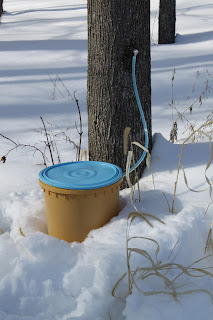 Waiting, waiting, waiting… we’re still waiting for sap. We tapped all our trees on Wednesday, when it
looked like the temperatures would creep above freezing. Not so much.
All we’ve got to show for our first few days are a couple of buckets
with a half-inch of frozen sap in the bottom.
It’s always a balancing act – if we tap too early (as we apparently did
this year), we risk having the holes in the trees heal up before all the available
sap is collected – the trees actually start healing the minute they’re tapped. But if we tap too late and miss the beginning
of the sap run, we’ll miss out on the delicately-flavored light amber maple
syrup that those first days will bring.
Waiting, waiting, waiting… we’re still waiting for sap. We tapped all our trees on Wednesday, when it
looked like the temperatures would creep above freezing. Not so much.
All we’ve got to show for our first few days are a couple of buckets
with a half-inch of frozen sap in the bottom.
It’s always a balancing act – if we tap too early (as we apparently did
this year), we risk having the holes in the trees heal up before all the available
sap is collected – the trees actually start healing the minute they’re tapped. But if we tap too late and miss the beginning
of the sap run, we’ll miss out on the delicately-flavored light amber maple
syrup that those first days will bring.
Our other sugar sources, the honey bees, are not happy about
the lingering freezing temperatures, either.
We’re not really worried about them freezing in their hives, since we
wrapped all the boxes with black tar paper to keep the wind out and the heat in. And even on a sub-zero day, a cluster of bees
and their body heat can reach 80 degrees.
But the bees still leave the hive for their periodic “cleansing flights,”
also known as “taking a little bee dump outside so they don’t turn the hive
into giant latrine.” Some of those bees
won’t survive out in the cold long enough to make it back to the hive.
The bees that don’t freeze their little bee butts off
outside the hive are probably getting a tad hungry by now. To keep our honey-creators alive through the
winter, we left 60-70 pounds of honey in each hive to provide enough sustenance
until spring. But with winter continuing
to stretch out, we’ve had to supplement their winter stash with some sugar
water. When they suck the sugar water
out of the feeder, they’re tricked into thinking the spring nectar is
flowing. Oh, if only we could trick ourselves into thinking spring is so
close!
